Digital design has been booming for the past few years. In the past, we required a web designer to handle all aspects of website design, from appearance to HTML template. However, it is a little more complicated nowadays.
Nowadays, designers are classified as UI, UX, CX, product, and service designers. The precise line separating their work becomes more and more elusive. In reality, all of these roles are interconnected and interact with one another. As a result, it is difficult to tell where one designer's work ends and another's begins.
Nevertheless, we will make an attempt to define the fundamental boundary between individual designers because it is their division, competence, and responsibility that is frequently discussed today.
Designer
The term "designer" refers to both creators and designers. It has historically been used to denote creative design in a variety of fields. However, as digital design and specialized roles have evolved, it has become clear that a general designer cannot meet all of the needs and skills that digital design necessitates. This term, however, is not limited to digital design and is used in a variety of industries, including interior design, fashion design, industrial design, and many more.
UI Designer (user interface)
A UI designer focuses on the visual appearance of websites, applications, e‑shops, and other digital products, with an emphasis on aesthetics and visual elements. Their job is to address colors, fonts, contrasts, element spacing, and other factors that contribute to the overall visual impression.
UI design is frequently the most discussed topic because it is simple to imagine, and everyone has an opinion on what is considered beautiful. Graphic design, on the other hand, is subjective, and everyone has different tastes. The design should ideally be created in accordance with the requirements for brand positioning, perception, and visual identity. However, it frequently slips into the fact that the visual form is created based on the client's requirements and preferences in combination with the brand's visual identity.
It is critical in UI design that the end product is not only aesthetically pleasing but also usable. The UI designer strives to make the product usable by people with various visual impairments as well as other health and mental disorders.
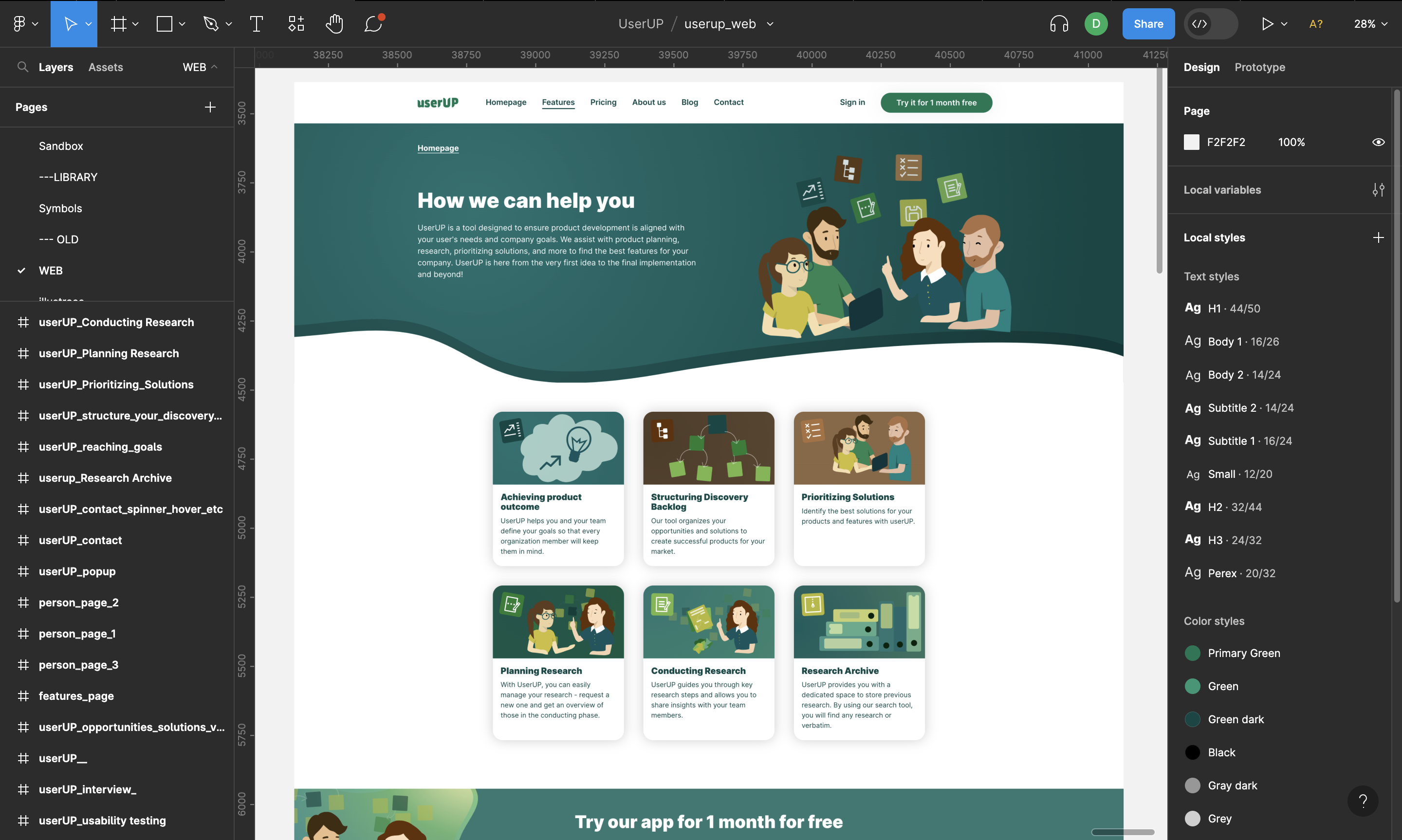 Output in Figma
Output in Figma
What a UI designer does: Draws a visual form, ideally based on a wireframe from a UX designer. The result is the final form of the website, e‑shop, or application.
Output: Nowadays, it's usually a visual created in Figma or another graphic tool (individual screens or specific components and their states). This smoothly transitions into the area of UX design, which focuses on the overall user experience.

UX Designer (user experience)
A UX designer focuses on creating user experiences in applications, websites, e‑shops, and other digital products. Their primary goal is to ensure that users have a positive product experience. The UX designer is concerned with whether the application meets the needs of the user, whether it is intuitive and clear, and whether it meets the users' expectations.
A UX designer's job entails creating wireframes and prototypes that are used to visualize and test the user interface. However, UX design extends far beyond the creation of a visual design. It also includes user research and testing, information architecture creation, user text writing, and accessibility and usability assurance.
While a single UX designer can handle all of these aspects (and would be a true superhero), it is advantageous to be able to divide this work into specialized roles. These include interaction design (IxD), which focuses on designing interactions and animations, UX copywriting, which specializes in writing texts and content, and UX research, which focuses on the collection and analysis of data from users.
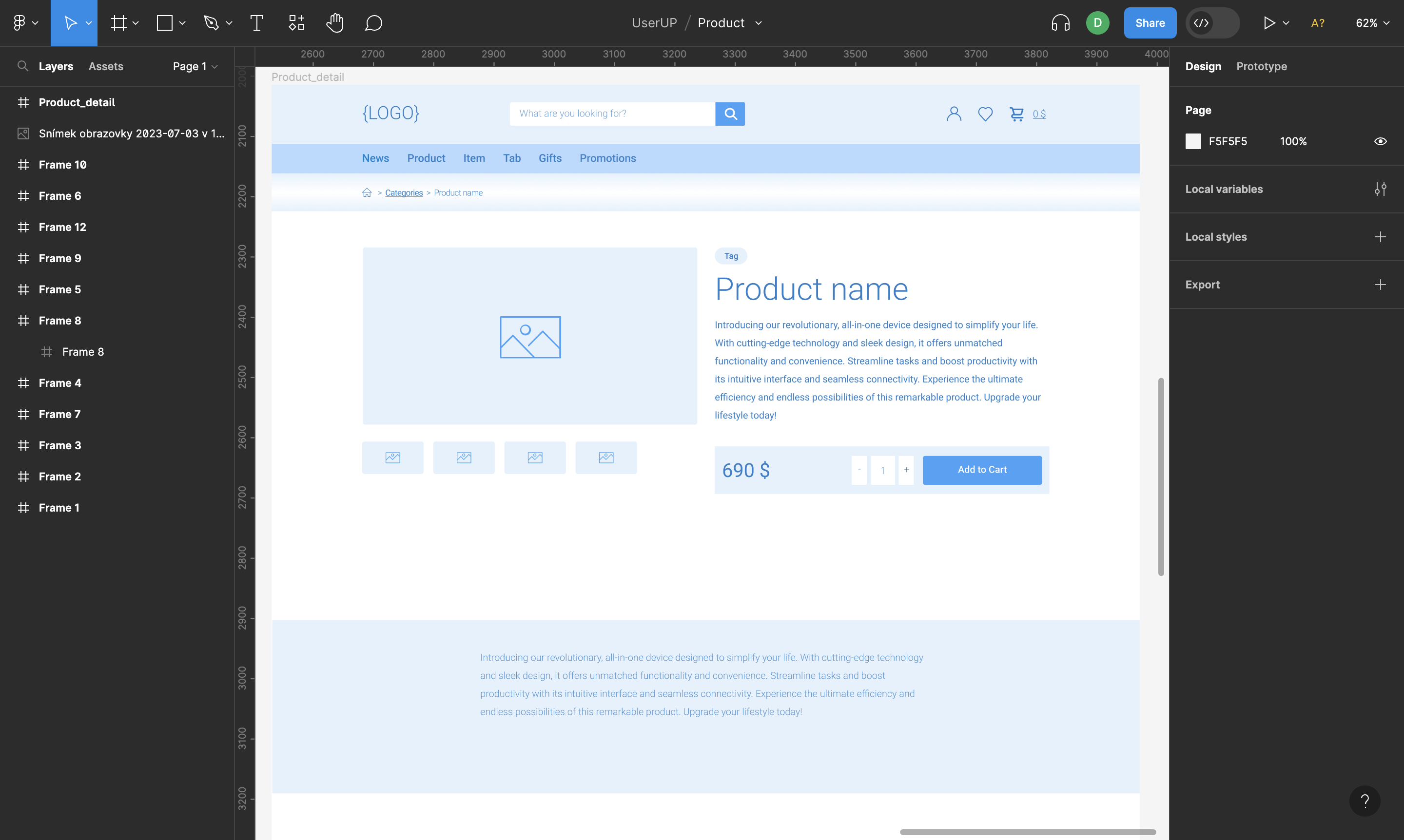
Output of interaction design like a wireframe
Each of these roles adds value, and collaboration between them contributes to a better user experience.
What a UX designer does: Creates wireframes and prototypes for the final product. Conducts user research. It identifies user needs and concerns and conducts various types of experiments, such as user or concept tests.
Output: A wireframe or prototype with correct text, which is typically tested by users. Wireframe created based on user requirements. Additionally, conversion rate optimization.
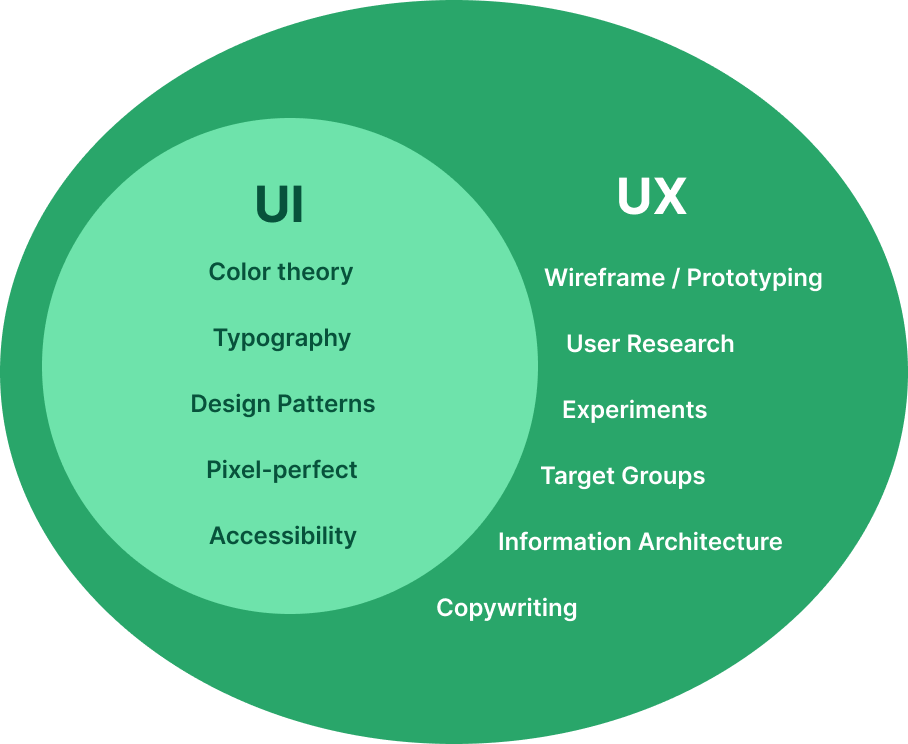
Product designer
A product designer is frequently confused with a "newer UX designer", but this is not the case. The most basic distinction between a product designer and a UX designer is that a UX designer is primarily concerned with the user. A product designer, on the other hand, must also consider business. As a result, they expand their field to include product management. Thus, product design is a field that combines UX and business.
To some extent, the product designer represents the product owner's role in the team. If a product owner is already on the team, a separate product designer is not always required.
A product designer's primary goal is to identify user needs that are relevant to the product while also being beneficial to the company. They also monitor the product outcome and select the most appropriate opportunities that bring the greatest benefit to the product and the company in the given time horizon. Furthermore, they assist in the development of various solutions that have already been tested with users and whose business benefit is known.
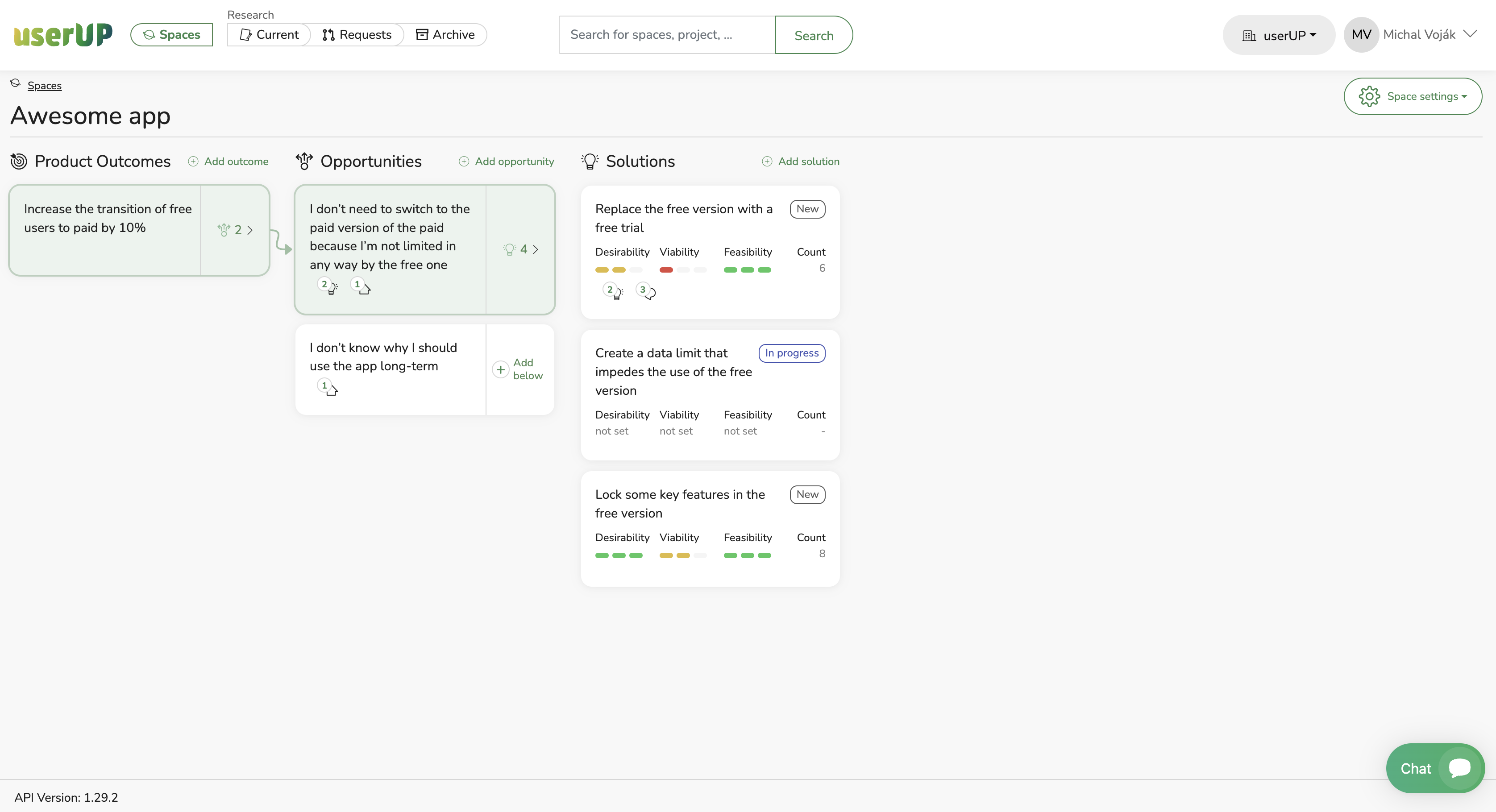
Connecting product outcomes with user needs and solutions in the form of an opportunity solution tree in the userUP tool
A product designer is responsible for developing product strategies, creating wireframes and prototypes, testing, and iteratively improving the product. They collaborate with the team, business leadership, and other stakeholders to ensure that the finished product meets business objectives and user expectations.
What a product designer does: Develops a product strategy, searches for opportunities and various solutions, and works with the team to optimally prioritize them in order to find solutions that will benefit users and the business at the time. If they are the only member of the team (which is not ideal), then they are responsible for everything from the field of UX design.
Outputs: A prioritized opportunity and solution space to clarify what the development team is currently supposed to do to achieve the best product outcome at the given time.

CX Designer (Customer experience)
A CX Designer is a specialist who specializes in the design of the overall customer experience associated with a company across multiple channels and touchpoints. Their primary goal is to provide customers with a positive, consistent, and enjoyable experience, which will increase customer loyalty and satisfaction.
Assume a customer makes a purchase in an online store (UX e‑shop) and then calls the customer service line (UX call center) with a question. A CX designer would track the entire customer journey, paying attention to how the customer felt throughout the process, their expectations, and how well the company could meet their needs.
CX Designers focus on the entire customer journey, tracking customers' interactions and experiences with a business from start to finish. This includes all touchpoints, such as websites, mobile apps, physical stores, customer service, and other services. The CX Designer strives to understand the needs, expectations, and preferences of customers in order to develop strategies and design solutions that meet those needs while exceeding customer expectations. This is then displayed using the Customer-journey map.
The CX Designer collaborates with other team members, such as UX designers, marketing specialists, analysts, and customer service managers, to provide the best overall customer experience possible.
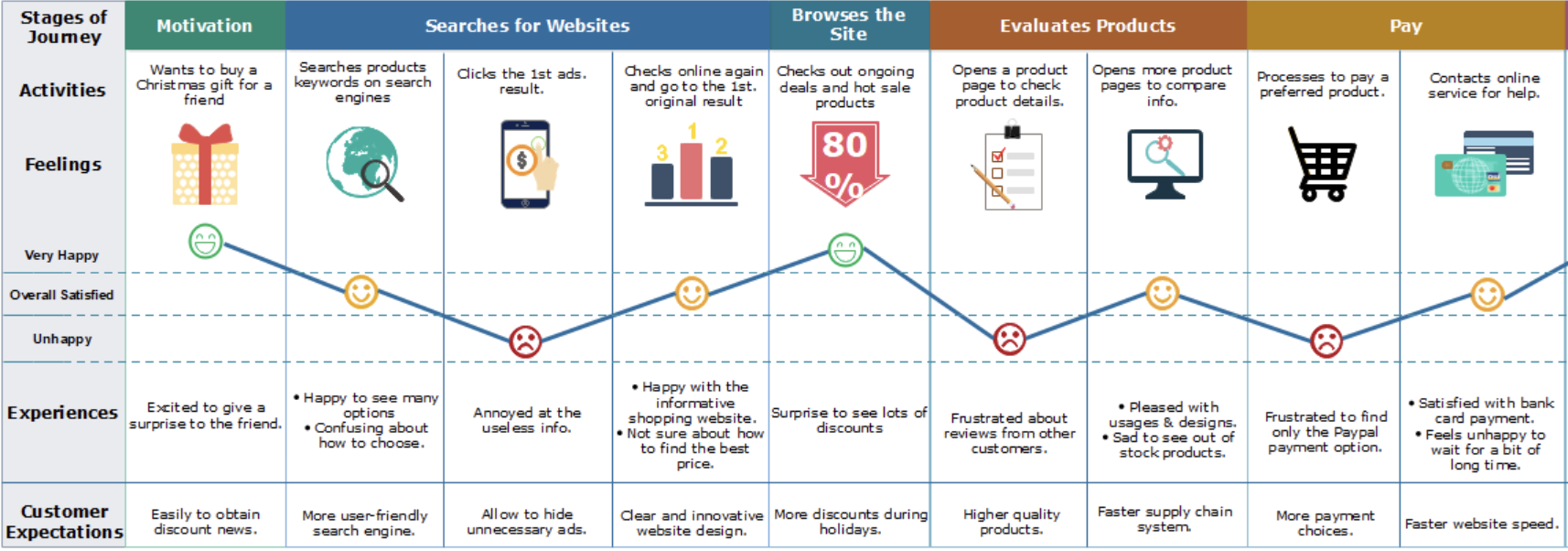 Customer journey map, source:https://www.edrawsoft.com/8-customer-journey-map-examples-to-inspire-you.html
Customer journey map, source:https://www.edrawsoft.com/8-customer-journey-map-examples-to-inspire-you.html
What a CX designer does: Analyzes customer data, conducts customer and behavior research, develops personas and customer journey maps, designs innovative customer experiences, and iterative testing and improvement.
Output: Custome-journey map, empathy map, target groups, personas, and so on.

Service designer
For a service designer, the definition can be a little hazy. Some compare them to a product designer, except that they focus on designing services rather than products.
Generally, the distinction between a product and a service is frequently associated with tangibility and ownership. A product is something tangible that can be purchased, held, and felt. A service, on the other hand, is an intangible experience or experience provided by a company, such as a visit to a gym or sauna.
In the digital world, the distinction between digital services and products becomes more complex as the lines between the two blur. We can use the definition that a digital product is purchased and owned with a one-time payment. On the contrary, you pay for the digital service on a regular basis and do not own it.
Unfortunately, if we rely too heavily on this definition, the distinction between a product designer and a service designer in the digital environment is minimal, if not non-existent. The only difference would be the payment method, though some digital products can be purchased both once as well as on a recurring basis. As a result, it is necessary to approach this issue with greater flexibility and consider the larger context and focus of these roles.
A service designer performs similar work to a CX designer but with a focus on the company's internal operations (Employ-centric). While the CX designer studies and maps the customer experience at various touchpoints, the service designer focuses on similar aspects but complements and expands them from the perspective of the company's internal functions. Their job is to organize people, map and improve internal processes and environments so that the company can provide quality services to its customers.
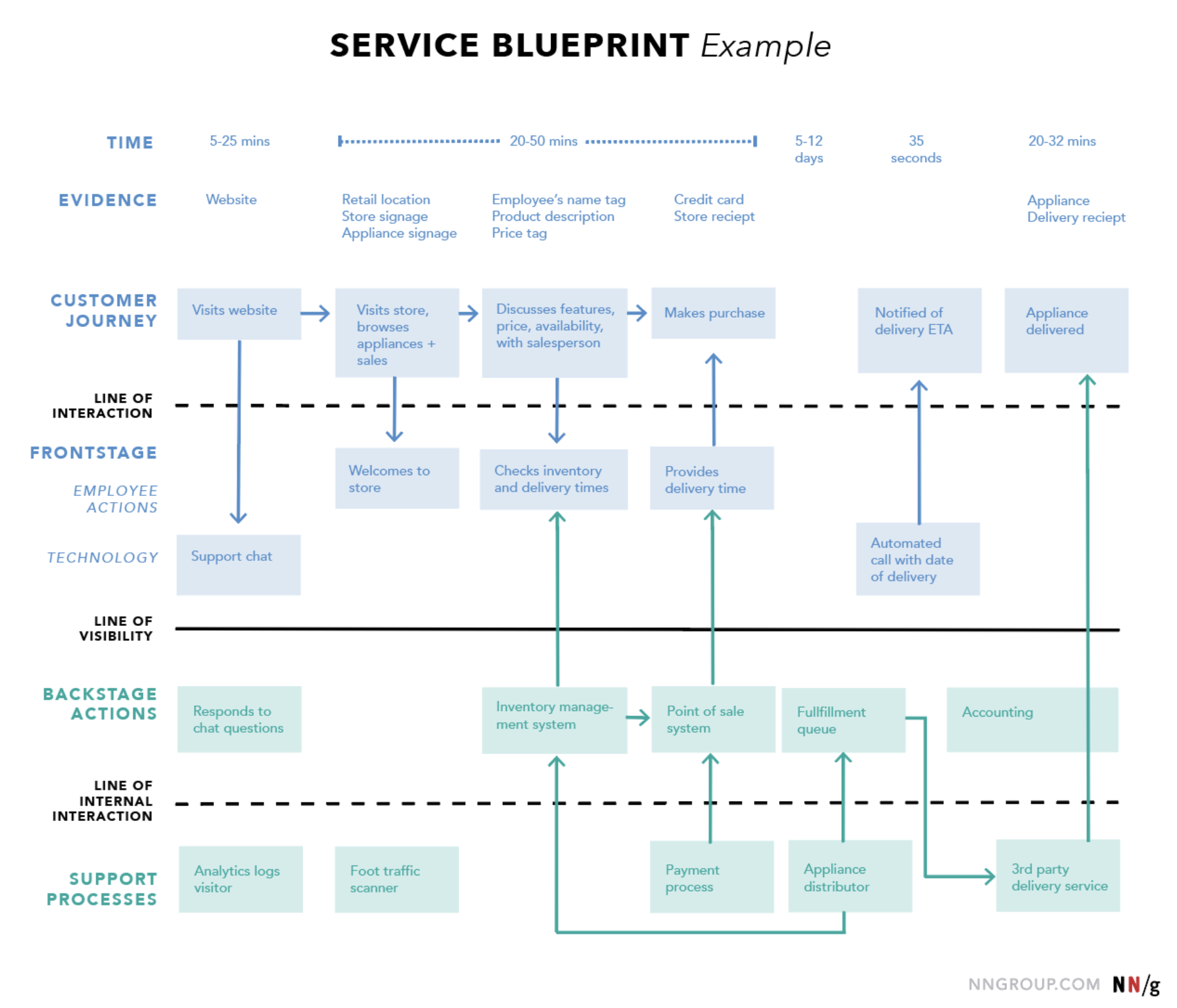
Services design blueprint, source: https://www.nngroup.com/articles/service-blueprints-definition/
It's about supporting products and touchpoints. Service design ensures that UX/product designers and CX designers provide the most value to users and customers. If the services do not function properly on the inside, this will not be possible on the outside. This is frequently demonstrated using a service blueprint.
An example would be when you want to offer your users a simple login to your application, but the login will be challenging due to the speed (outdated solutions) and manual operator verification (internal security conditions) of the systems you use for this. Other designers are unable to provide a quality service to users because they are hampered by internal services that make it impossible.
What a service designer does: Researches and improves the internal environment, processes, infrastructure, internal communication, and tools.
Output: Services blueprint and services flow chart.

Role overlaps
It frequently happens that one role solves more issues than some definitions allow, and it doesn't really matter. If the designer in question possesses the necessary skills and knowledge, this is not a problem as these areas overlap and complement each other so much. It is difficult to clearly define the boundaries where one ends and the other begins. When working on products, especially in large companies and corporations with many interconnected products, it is critical to share acquired knowledge with one another in order to achieve the best possible result.
Of course, the article's role descriptions are brief. Roles frequently include additional tasks and responsibilities not listed here. The article focuses primarily on the fundamental differences between these roles.
Resources
- https://pierreneis.medium.com/experiences-ux-cx-sx-px-ox-ex-20ab18d6fb61
- https://medium.com/@ysfqwe1/experience-design-vs-service-design-in-singapore-78e3f0035fb6
- https://blog.ulawpractice.com/what-is-bx-cx-ux-and-px-cpd-webinar
- https://www.interaction-design.org/literature/topics/service-design
- https://www.nngroup.com/articles/service-design-101/
- https://www.nngroup.com/articles/ux-vs-service-design/
- https://www.nngroup.com/articles/service-blueprints-definition/
- https://www.interaction-design.org/literature/article/the-principles-of-service-design-thinking-building-better-services
- https://www.youtube.com/watch?v=-usUuyrLhL4


